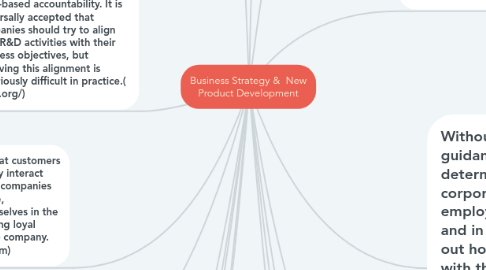Business Strategy & New Product Development
by Isabelle Zamora

1. Managers that visualize the consumer using the product are cognitive biased and more likely to ignore negative reviews and sales forecasts (DeRosia, E. D., & Elder, R. S). This is not good business strategy and will create unnecessary expenses and the production of a sub par product.
2. Clearly defined conceptual vision and expected outcomes for product builds from executive leadership (Forbes).
3. Determine the strategy of the company as either being a Pioneer, fast follower, cost leader or a customer centric organization. (Vision Edge marketing)
4. Need to understand your market segmentation and where you are targeting the product. (Journal of consumer Marketing)
5. Setting a Technology Management Architecture can help a company to link R&D to strategy and maximize its return on its R&D efforts. These were the main goals of a recent assignment with one of the largest Brazilian companies and a world’s leading player in the steel industry. (strategos.com)
6. With insight into what customers expect and how they interact with their offerings, companies can stay competitive, differentiating themselves in the market and cultivating loyal clients who trust the company. (hanoverresearch.com)
7. Holland et al. (2000) suggested that the critical success factors for cross-functional teamwork in NPD include strategic alignment between functions, a climate supportive of teamwork and team-based accountability. It is universally accepted that companies should try to align their R&D activities with their business objectives, but achieving this alignment is notoriously difficult in practice.( jgbm.org/)
8. Firms need to assess their current align with respect to marketing, IT and business strategy. Businesses need to develop a triadic strategy where they factor in all three strategies instead of focusing on one. Therefore they can determine if they are a prospector (customer centered), defender (competitor centered) or analyzer (combination of prospector and defender) (Al-Surmi, A., Cao, G., & Duan, Y.).
9. Documenting a plan to explain how you want innovation to happen and the specific goals you are expecting is an integral part of successful outcomes in product development. "You have mapped out what you are hoping to discover, how it matches with the company’s vision and overarching objectives, and have at least a vague understanding that there will be various roads to reach an indeterminable set of outcomes, each with unique yet important milestones along the way. (Eden, 2019)"
10. Business strategy affects the information environment. Businesses that incorporate a prospector approach create more press releases and have more news coverage (Bentley-Goode, K. A., Omer, T. C., & Twedt, B. J.). This strategy in turn gives more visibility to new products being released by that company which could possibly reduce the cost of marketing.
11. Understanding the target audience tailors the product development need. (Queensland Government)
12. Success occurs through the review phase and a conceptual model (Springerlink).
13. Your product strategy must support the company’s ability to deliver on its current strategy; if not, your product will be seen as diverting resources away from the “greater good.” (280group.com)
14. A simple three step approach using some very basic methodology is all you need to align your innovation activities with your strategy. You simply need to ask some probing questions, follow creative problem solving (CPS) in idea generation and have experts judge ideas using clearly defined business criteria. (innovationmanagement.com)
15. By fulfilling gaps within the market with new products, a new set of customers will be created (Nawale, A& Nagare, M.).
16. The company is more likely to spend a higher budget on marketing of a product they are unsure will sell without the added marketing strategy (Park, K. M., Chintagunta, P. K., & Suk, I).
17. Without clear direction and guidance from leadership to determine the appropriate corporate strategy, employees are left confused and in the dark in figuring out how their work aligns with the company. "With no guiding corporate strategy, the team is unsure how the day-to-day tactical activities link back to the company’s strategic direction"(Actuating Consulting).


